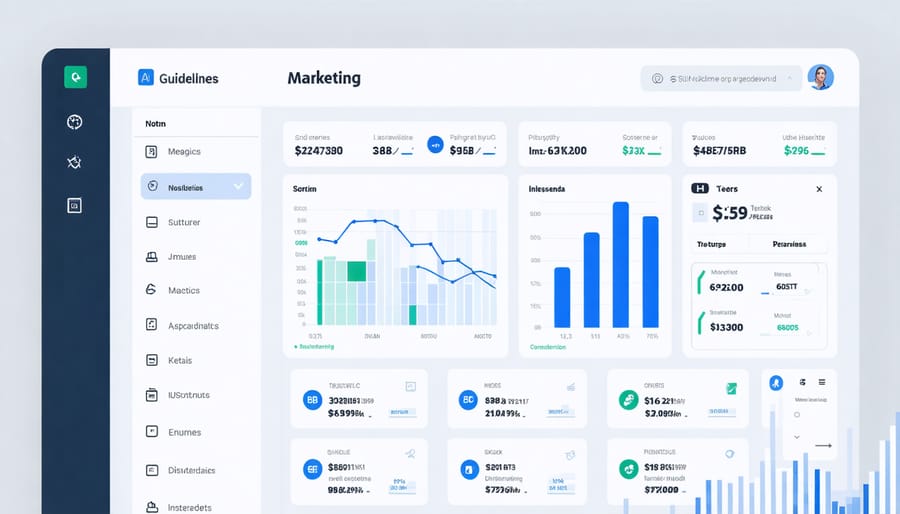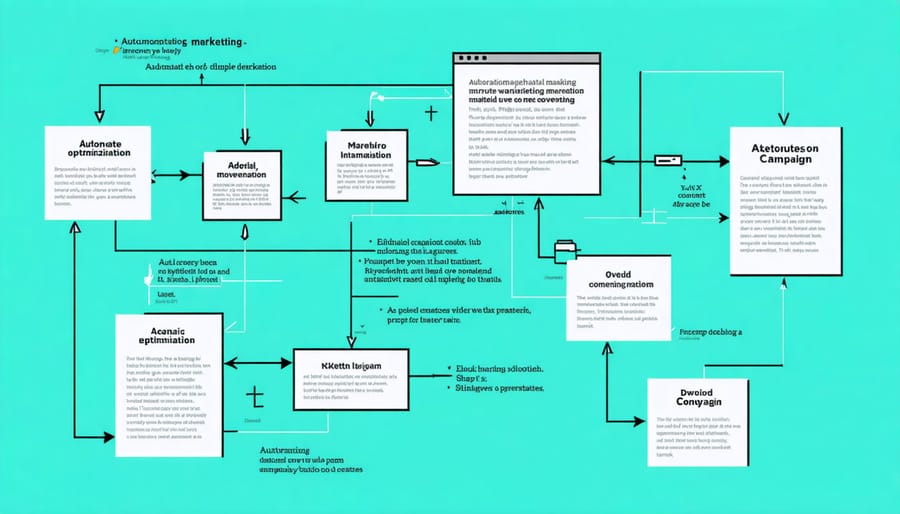AI-Powered RRM Transforms Digital Marketing Performance Tracking

Transform your marketing analytics with AI-enhanced Revenue Resource Management (RRM) to unlock unprecedented growth potential and data-driven decision-making. Modern marketers face an increasingly complex landscape of customer interactions, attribution models, and revenue streams – AI-powered RRM systems cut through this complexity by automating data analysis, predicting customer behavior, and optimizing resource allocation in real-time.
By integrating machine learning algorithms with traditional RRM frameworks, businesses can now identify revenue opportunities 5x faster and reduce forecasting errors by up to 30%. This revolutionary approach combines predictive analytics, natural language processing, and automated decision engines to deliver actionable insights that drive measurable ROI improvements across marketing channels.
The convergence of artificial intelligence and RRM represents a paradigm shift in how organizations track, analyze, and optimize their marketing performance. Forward-thinking companies leveraging these AI enhancements report significant advantages in customer acquisition costs, lifetime value calculations, and campaign optimization – creating a sustainable competitive edge in today’s data-driven marketplace.
Whether you’re a startup looking to scale efficiently or an established enterprise seeking to maximize marketing ROI, AI-enhanced RRM provides the intelligent automation and predictive capabilities needed to succeed in modern digital marketing.
What Makes AI-Enhanced RRM a Game-Changer
Real-Time Data Processing Capabilities
AI-enhanced RRM systems excel at processing vast amounts of marketing data in real-time, enabling businesses to make informed decisions without delay. Through advanced real-time data analytics, these systems can simultaneously monitor multiple marketing channels, track customer interactions, and analyze performance metrics within milliseconds.
The processing capabilities extend beyond simple data collection, incorporating pattern recognition and predictive modeling to identify trends before they become apparent through traditional analysis methods. This instant processing power allows marketing teams to adjust campaigns on the fly, optimize ad spend, and respond to market changes immediately.
Key features of the real-time processing system include:
– Continuous monitoring of campaign performance metrics
– Instant analysis of customer behavior patterns
– Automated adjustment of marketing parameters
– Immediate detection of anomalies or opportunities
– Seamless integration with existing marketing platforms
This rapid processing capability ensures that businesses can maintain competitive advantage by responding to market dynamics instantly, rather than waiting for periodic reports or manual analysis. The system’s ability to handle massive data volumes while delivering actionable insights makes it an invaluable tool for modern marketing operations.

Automated Pattern Recognition
The AI-enhanced RRM system excels at identifying meaningful patterns and trends within your marketing data that might otherwise go unnoticed. By continuously analyzing vast amounts of customer interactions, campaign performance metrics, and engagement data, the system automatically detects correlations and recurring patterns that can inform strategic decisions.
This automated pattern recognition capability works across multiple channels simultaneously, monitoring everything from social media engagement rates to email campaign performance. The system can quickly identify which content types perform best at specific times, which customer segments respond to particular messaging styles, and which combination of marketing tactics yields the highest ROI.
For example, the system might recognize that your B2B customers are most responsive to email campaigns sent on Tuesday mornings, while your social media engagement peaks during evening hours. These insights are delivered in real-time, allowing marketing teams to adjust their strategies proactively rather than waiting for manual analysis of campaign results.
The pattern recognition functionality also helps identify potential issues before they impact campaign performance, enabling preventive actions and continuous optimization of marketing efforts.
Implementing AI-RRM in Your Marketing Strategy

Setting Up Performance Metrics
Establishing effective performance metrics is crucial for maximizing the potential of your AI-enhanced RRM system. Start by identifying key performance indicators (KPIs) that align with your business objectives. These typically include conversion rates, customer engagement levels, response times, and ROI metrics.
To implement a comprehensive tracking system, focus on these essential metrics:
1. Customer Response Rate: Track how quickly and effectively your automated system responds to inquiries
2. Engagement Quality Score: Measure the relevance and personalization of automated interactions
3. Conversion Tracking: Monitor leads generated and sales completed through AI-assisted channels
4. Cost per Acquisition: Calculate the efficiency of your AI-enhanced marketing efforts
AI-powered marketing insights can help you monitor these metrics in real-time, allowing for quick adjustments and optimization. Set up automated reporting dashboards that display these metrics clearly and accessibly.
Remember to establish baseline measurements before implementing AI enhancements, enabling you to accurately measure improvements. Review and adjust your metrics quarterly to ensure they remain aligned with your evolving business goals. Consider implementing A/B testing to compare AI-enhanced performance against traditional methods, providing concrete evidence of ROI and areas for improvement.
Integration with Marketing Tools
Modern AI-enhanced RRM solutions offer seamless integration capabilities with popular marketing platforms, making it easier to consolidate your marketing efforts and data analysis. Most AI-RRM systems support direct connections with major CRM platforms like Salesforce, HubSpot, and Zoho, allowing for automatic data synchronization and real-time updates.
To integrate your AI-RRM system with existing marketing tools, start by identifying your primary marketing platforms and checking their API compatibility. Many AI-RRM providers offer pre-built connectors for common marketing automation tools, email marketing platforms, and social media management systems. These connections enable automated data flow, reducing manual data entry and potential errors.
For analytics integration, AI-RRM systems typically connect with Google Analytics, Adobe Analytics, and other major tracking platforms. This integration provides a comprehensive view of your marketing performance by combining website analytics with relationship management data.
Custom integrations are also possible through REST APIs and webhooks, though these may require technical expertise. Many providers offer integration support services to help set up these connections effectively.
To maximize the benefits of integration, ensure your marketing team is trained on the connected systems and establish clear workflows for data management. Regular audits of your integrated systems will help maintain data accuracy and system performance, ensuring your AI-RRM solution continues to deliver value across your marketing technology stack.
Maximizing ROI with AI-Enhanced Performance Tracking
Data-Driven Decision Making
AI-powered RRM platforms transform raw data into actionable marketing intelligence, enabling businesses to make informed decisions based on real-time analytics and predictive insights. By analyzing patterns in customer behavior, campaign performance, and market trends, these systems provide recommendations that help optimize marketing strategies and resource allocation.
The decision-making process becomes more sophisticated through machine learning algorithms that continuously learn from past outcomes. These algorithms can identify which marketing channels deliver the best ROI, determine optimal timing for campaign launches, and predict customer responses to different marketing approaches. This data-driven approach eliminates guesswork and reduces the risk of unsuccessful marketing initiatives.
For example, AI systems can analyze historical campaign data to recommend the most effective content types for specific audience segments, suggest optimal ad spend distribution across channels, and identify potential market opportunities before competitors. The technology also helps in personalizing marketing messages by understanding customer preferences and behavior patterns at scale.
Marketing teams can leverage these insights to:
– Allocate budgets more effectively across channels
– Optimize campaign timing and frequency
– Identify and target high-value customer segments
– Adjust messaging based on real-time performance data
– Predict and prevent customer churn
By incorporating AI-driven insights into the decision-making process, businesses can achieve higher marketing efficiency, better customer engagement, and improved ROI on their marketing investments.
Automated Campaign Optimization
Automated campaign optimization represents a significant breakthrough in digital marketing efficiency. By leveraging artificial intelligence, RRM systems continuously monitor campaign performance metrics and make real-time adjustments to maximize results.
The AI engine analyzes multiple data points simultaneously, including click-through rates, conversion metrics, engagement levels, and ROI indicators. Based on this analysis, it automatically fine-tunes various campaign elements such as bid strategies, audience targeting, and creative asset distribution.
What sets this technology apart is its ability to learn from previous campaign outcomes. The system identifies patterns in successful campaigns and applies these insights to optimize future marketing efforts. For instance, if certain audience segments show higher engagement during specific times, the AI automatically adjusts scheduling to capitalize on these peak periods.
The optimization process also extends to budget allocation, ensuring marketing spend is directed toward the most effective channels and tactics. When performance metrics indicate underperforming elements, the system automatically reallocates resources to better-performing areas, maintaining optimal cost-efficiency.
This dynamic approach eliminates the need for constant manual monitoring and adjustment, saving valuable time while improving campaign effectiveness. The system’s ability to make data-driven decisions in real-time ensures campaigns remain responsive to market changes and consumer behavior shifts, ultimately delivering better results with less human intervention.

The integration of AI-enhanced RRM in digital marketing represents a significant leap forward in how businesses track, analyze, and optimize their marketing efforts. By automating data collection and analysis processes, companies can now make faster, more informed decisions while reducing human error and operational costs. The technology has proven particularly valuable for businesses seeking to maintain competitive advantages in rapidly evolving digital landscapes.
Looking ahead, AI-enhanced RRM is poised to become even more sophisticated and accessible. Machine learning algorithms will continue to improve, offering more precise predictions and deeper insights into customer behavior. We can expect to see enhanced personalization capabilities, more accurate attribution modeling, and seamless integration with emerging marketing channels.
For businesses considering implementation, the benefits clearly outweigh the initial investment. Improved ROI tracking, automated reporting, and real-time optimization capabilities provide tangible advantages that directly impact bottom-line results. Small and medium-sized enterprises, in particular, stand to gain significant advantages through more efficient resource allocation and data-driven decision-making.
To stay competitive in the digital marketing space, organizations should begin exploring AI-enhanced RRM solutions now rather than later. The technology’s ability to scale with business growth while maintaining accuracy and efficiency makes it an invaluable tool for modern marketing operations. As the technology continues to evolve, early adopters will be better positioned to leverage new features and capabilities, ensuring their marketing strategies remain effective and future-proof.
Leave a Reply